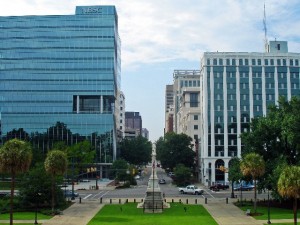‘Columbia’ Category
» posted on Saturday, February 23rd, 2013 by Linda Lou Burton
Back For The Future
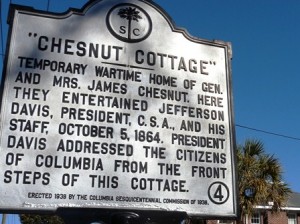 Linda Burton posting from Columbia, South Carolina – Mary Chesnut and Catherine Bruce. I want you to remember those two names. Though born in different centuries, these women have several things in common. First of all, they both lived a part of their lives on Hampton Street in Columbia, South Carolina. Catherine still does; she owns and resides in the Visanska-Starks house at 2214. And Mary lived for a time during the Civil War in what is now a B&B called “The Chesnut Cottage” at 1718. Neither place is open to the public as a house museum, but both sites are identified by Historic Markers strategically placed near their front sidewalk. It was near one of those markers that I met Catherine Bruce; I was in front of the Chesnut Cottage marveling
Linda Burton posting from Columbia, South Carolina – Mary Chesnut and Catherine Bruce. I want you to remember those two names. Though born in different centuries, these women have several things in common. First of all, they both lived a part of their lives on Hampton Street in Columbia, South Carolina. Catherine still does; she owns and resides in the Visanska-Starks house at 2214. And Mary lived for a time during the Civil War in what is now a B&B called “The Chesnut Cottage” at 1718. Neither place is open to the public as a house museum, but both sites are identified by Historic Markers strategically placed near their front sidewalk. It was near one of those markers that I met Catherine Bruce; I was in front of the Chesnut Cottage marveling 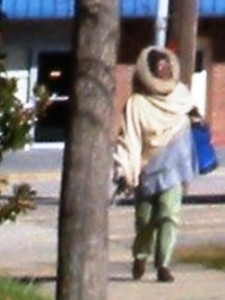 that I was there and snapping pictures, of course. A woman passed by, bundled against the blustery afternoon wind. She commented about my camera; I commented about her headscarf; then she spotted my car and our conversation began. Catherine, it turns out, is a doctoral student at USC; she was headed for the library. She asked about my Journey and I asked about her studies but it was much too cold to stand and talk; we agreed to meet for lunch later in the week. And that’s when I discovered what else Mary Chesnut and Catherine Bruce have in common. » read more
that I was there and snapping pictures, of course. A woman passed by, bundled against the blustery afternoon wind. She commented about my camera; I commented about her headscarf; then she spotted my car and our conversation began. Catherine, it turns out, is a doctoral student at USC; she was headed for the library. She asked about my Journey and I asked about her studies but it was much too cold to stand and talk; we agreed to meet for lunch later in the week. And that’s when I discovered what else Mary Chesnut and Catherine Bruce have in common. » read more
» posted on Thursday, February 21st, 2013 by Linda Lou Burton
Leapin’ Lizards!
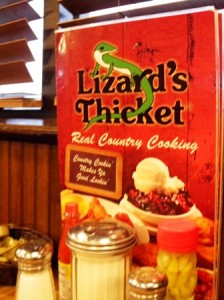 Linda Burton posting from Columbia, South Carolina – Home Meal Replacement. That’s the designation the Lizard’s Thicket country cooking restaurants give themselves, and it fits. As I stood at the counter to pay my bill, a woman just ahead placed her “To Go” order – green beans, squash casserole, cornbread dressing, and a triple portion of meatloaf. “I’ll be able to get it all on the table before my husband gets home,” she said, looking very pleased. She moved onto a counter stool to wait and I turned and told her about a restaurant in Tennessee that provided eggshells and potato peels for your garbage can, so you could convince your husband you cooked it all. “Honey,” she replied, “as good as this food is, my husband will know I didn’t cook it!” Apparently these are the sentiments of much of the population of Columbia; they enthusiastically support 15 Lizard’s Thicket “country
Linda Burton posting from Columbia, South Carolina – Home Meal Replacement. That’s the designation the Lizard’s Thicket country cooking restaurants give themselves, and it fits. As I stood at the counter to pay my bill, a woman just ahead placed her “To Go” order – green beans, squash casserole, cornbread dressing, and a triple portion of meatloaf. “I’ll be able to get it all on the table before my husband gets home,” she said, looking very pleased. She moved onto a counter stool to wait and I turned and told her about a restaurant in Tennessee that provided eggshells and potato peels for your garbage can, so you could convince your husband you cooked it all. “Honey,” she replied, “as good as this food is, my husband will know I didn’t cook it!” Apparently these are the sentiments of much of the population of Columbia; they enthusiastically support 15 Lizard’s Thicket “country 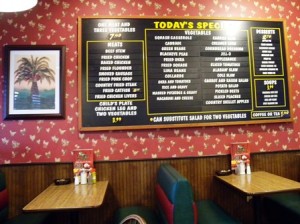 cooking” restaurants around the city, and, as I was informed by the manager of one, “49% of our business comes from Take Home.” But people like to eat in the restaurants too, hanging out with neighbors and friends in a comfortable booth facing the big blackboard on the wall that lists the 25 vegetables they serve (yes, macaroni and cheese IS a vegetable). And being waited on by a staff that seems to remember faces, and preferences. » read more
cooking” restaurants around the city, and, as I was informed by the manager of one, “49% of our business comes from Take Home.” But people like to eat in the restaurants too, hanging out with neighbors and friends in a comfortable booth facing the big blackboard on the wall that lists the 25 vegetables they serve (yes, macaroni and cheese IS a vegetable). And being waited on by a staff that seems to remember faces, and preferences. » read more
» posted on Tuesday, February 19th, 2013 by Linda Lou Burton
Bootjacks And Cabbages
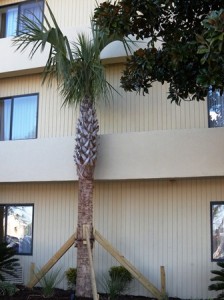 Linda Burton posting from Columbia, South Carolina – “About $800.00” That was the answer to my question, “How much does a big tree like that cost?” I was referring to the large palmetto trees on the grounds of my hotel, propped securely in place by a system of support boards angled to hold them upright. The newly planted trees are more than twenty feet tall at the moment, offering a “South Carolina look” on each side of the doorway. They have been planted at the entrance to the parking lot as well; the signs beside read “Pardon Our Dirt.” A South Carolina look? For sure; the palmetto is the state tree and has been on the state flag since 1861. It is part of the design on the state quarter, issued in 2000, and its image occupies the center spot on the South Carolina vehicle license plate. Real live palmettos frame almost every residential lawn and there is even a “Palmetto Trail”
Linda Burton posting from Columbia, South Carolina – “About $800.00” That was the answer to my question, “How much does a big tree like that cost?” I was referring to the large palmetto trees on the grounds of my hotel, propped securely in place by a system of support boards angled to hold them upright. The newly planted trees are more than twenty feet tall at the moment, offering a “South Carolina look” on each side of the doorway. They have been planted at the entrance to the parking lot as well; the signs beside read “Pardon Our Dirt.” A South Carolina look? For sure; the palmetto is the state tree and has been on the state flag since 1861. It is part of the design on the state quarter, issued in 2000, and its image occupies the center spot on the South Carolina vehicle license plate. Real live palmettos frame almost every residential lawn and there is even a “Palmetto Trail” 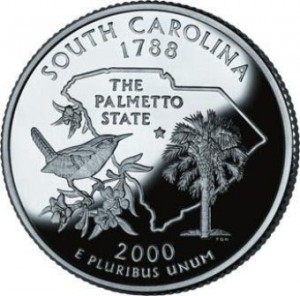 through the state, connecting the mountains of South Carolina to the coast, and running right through the state capitol lawn in downtown Columbia. The sabal palmetto, also known as the “cabbage palm” is the state tree of Florida too, and is native to the subtropical warm and temperate southeastern United States, as well as Cuba and the Bahamas. Can you guess why it is called a “cabbage” palm? And what on earth is a bootjack? » read more
through the state, connecting the mountains of South Carolina to the coast, and running right through the state capitol lawn in downtown Columbia. The sabal palmetto, also known as the “cabbage palm” is the state tree of Florida too, and is native to the subtropical warm and temperate southeastern United States, as well as Cuba and the Bahamas. Can you guess why it is called a “cabbage” palm? And what on earth is a bootjack? » read more
» posted on Sunday, February 17th, 2013 by Linda Lou Burton
And Here’s The Steeple
Linda Burton posting from Columbia, South Carolina – It was a little more peaceful in downtown Columbia today than it was on this day 148 years ago. February 17 was the day in 1865 when much of Columbia was burned; General Wade Hampton’s Confederate cavalry surrendered the city to General William Sherman’s Union troops; a story that is told and retold in historical markers all over town. Today’s downtown is moderate in size; the streets are wide and palmettos edge the sidewalks. The tallest buildings appear to be banks, clustered near the State House on Main, or Gervais, but holding their own in the height department are the church steeples, some topped with crosses, some not. Columbia is a “planned” city; it was chosen as the new state capital in 1786, incorporated as a village in 1805 and a city in 1854. Designed as a town of 400 blocks in a 2-mile square along the river, the blocks were divided in lots of 0.5 acres; perimeter streets and two through streets were 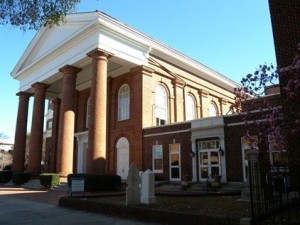 150 feet wide. Thank the mosquito for that – it was the belief at the time that dangerous mosquitos could not fly more than 60 feet without dying of starvation! As I drove those wide streets today, I couldn’t help but notice steeples poking up everywhere, so the GPS and I decided to do a little bird-dog tracking. It was an easy search on a sleepy Sunday afternoon; traffic was almost nil. I tried to imagine the noise of 1865, the smoke, and the fear. What would be burned next? What saved? And that led me to the First Baptist Church. » read more
150 feet wide. Thank the mosquito for that – it was the belief at the time that dangerous mosquitos could not fly more than 60 feet without dying of starvation! As I drove those wide streets today, I couldn’t help but notice steeples poking up everywhere, so the GPS and I decided to do a little bird-dog tracking. It was an easy search on a sleepy Sunday afternoon; traffic was almost nil. I tried to imagine the noise of 1865, the smoke, and the fear. What would be burned next? What saved? And that led me to the First Baptist Church. » read more
» posted on Friday, February 15th, 2013 by Linda Lou Burton
The Best Laid Plans
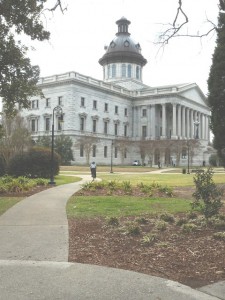 Linda Burton posting from Columbia, South Carolina – How long does it take to build a State House? When you’ve been around as long as South Carolina, it might take a while. South Carolina was one of the Thirteen Colonies, you know, and was the first to declare independence from the British Crown (March 26, 1776) when it adopted the “Constitution of South Carolina” and became the first republic in America. But that didn’t last long; it was also the first to ratify the initial governing document of the United States, the Articles of Confederation (February 5, 1778). It was the 8th state to come into the Union (May 23, 1788) and the first state to secede from that same Union (December 20, 1860). After a costly war that killed more than a third of the state’s male population, it was readmitted to the Union June 25, 1868. Where, and in what buildings, did
Linda Burton posting from Columbia, South Carolina – How long does it take to build a State House? When you’ve been around as long as South Carolina, it might take a while. South Carolina was one of the Thirteen Colonies, you know, and was the first to declare independence from the British Crown (March 26, 1776) when it adopted the “Constitution of South Carolina” and became the first republic in America. But that didn’t last long; it was also the first to ratify the initial governing document of the United States, the Articles of Confederation (February 5, 1778). It was the 8th state to come into the Union (May 23, 1788) and the first state to secede from that same Union (December 20, 1860). After a costly war that killed more than a third of the state’s male population, it was readmitted to the Union June 25, 1868. Where, and in what buildings, did 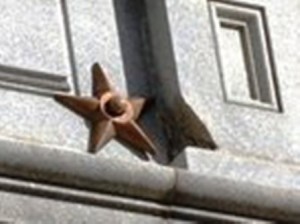 all these important statehood decisions take place? As I walked around the grounds of the State House in use today, I saw bronze stars noting Civil War cannon damage, plaques identifying the building’s architects, and a 1976 National Historic Landmark designation. A lot of history here, and, I learned, a lot of ups and downs. Sometimes even the best-laid plans have to change. » read more
all these important statehood decisions take place? As I walked around the grounds of the State House in use today, I saw bronze stars noting Civil War cannon damage, plaques identifying the building’s architects, and a 1976 National Historic Landmark designation. A lot of history here, and, I learned, a lot of ups and downs. Sometimes even the best-laid plans have to change. » read more
» posted on Wednesday, February 13th, 2013 by Linda Lou Burton
Famously Hot
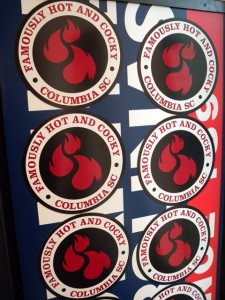 Linda Burton posting from Columbia, South Carolina – If you’ve got it, flaunt it, the saying goes, and Columbia jumps ahead of the game by promoting itself as “Famously Hot.” Does that refer to the climate? Or is it sizzling with things to do? Well I’m checking it out – in addition to the undisputed facts, just how hot is it? An undisputed fact is that Columbia is the capital of South Carolina, and has been since March 22, 1786, by legislative vote. It is also the largest city in the state (population 129,272, US Census 2010), and the US Army’s largest and most active training center, Fort Jackson, has officially been within the city limits since 1968 (by Pentagon approval). A geographic fact is that Columbia, like many colonial cities, is located on a “fall line;” that point in a river where you can’t float your boat upstream any more, and there isn’t enough water force coming downstream to power a mill (the Saluda and Broad Rivers meet here, and form the Congaree). An educational fact is that the University of South Carolina was founded here in 1801 (as South Carolina College); its initial hope was to attract young men from both the “Backcountry” and the “Lowcountry” and keep them from heading off to England for their education. Did they find Columbia hot? » read more
Linda Burton posting from Columbia, South Carolina – If you’ve got it, flaunt it, the saying goes, and Columbia jumps ahead of the game by promoting itself as “Famously Hot.” Does that refer to the climate? Or is it sizzling with things to do? Well I’m checking it out – in addition to the undisputed facts, just how hot is it? An undisputed fact is that Columbia is the capital of South Carolina, and has been since March 22, 1786, by legislative vote. It is also the largest city in the state (population 129,272, US Census 2010), and the US Army’s largest and most active training center, Fort Jackson, has officially been within the city limits since 1968 (by Pentagon approval). A geographic fact is that Columbia, like many colonial cities, is located on a “fall line;” that point in a river where you can’t float your boat upstream any more, and there isn’t enough water force coming downstream to power a mill (the Saluda and Broad Rivers meet here, and form the Congaree). An educational fact is that the University of South Carolina was founded here in 1801 (as South Carolina College); its initial hope was to attract young men from both the “Backcountry” and the “Lowcountry” and keep them from heading off to England for their education. Did they find Columbia hot? » read more

